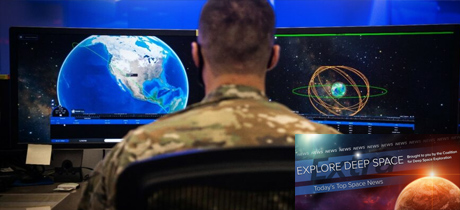In Today’s Deep Space Extra… The James Webb Space Telescope team has begun the alignment of the observatory’s large primary mirror. NASA honors Black History Month. India aims at August launch for lunar lander.
Human Space Exploration
When the International Space Station retires, it will plunge into the ocean to die, NASA says
Seattle Times (2/3): This week, NASA provided Congress with an update to its strategy for transitioning the agency’s human research and technology development activities aboard an aging International Space Station (ISS) to commercially assembled and operated replacements. The Biden-Harris administration has expressed support for extending NASA-led operations of the orbital lab from 2024 to 2030. In early 2031 after a carefully managed and gradual lowering of its altitude, the space station would destructively de-orbit into an uninhabited region of the Pacific Ocean.
Space Science
The alignment of NASA’s James Webb Space Telescope has begun
Space.com (2/2): NASA reported Thursday that it has initiated the alignment of the 18 elements that comprise the primary mirror of the James Webb Space Telescope (JWST). The large observatory was launched in a folded-up configuration on December 25, 2021. The in-space deployment that followed and the alignment of the primary mirror elements at its new home about one million miles from Earth will enable the JWST to study the earliest stars and galaxy formation and assess the atmospheres of exoplanets for signs of possible biological activity.
The chances of early life on Mars faced a meteorite problem
Space.com (2/4): Early chances for life on Mars might have been diminished by meteorites. A new study suggests that a period of heavy cratering on the Red Planet (and elsewhere in the solar system) persisted 30 million years longer than thought. Studies of the Late Heavy Bombardment, as this period is called, also has implications for the rise of life on Earth. The new study is largely based upon a meteorite known as Northwest Africa (NWA) 7034, nicknamed “Black Beauty.” The meteorite includes part of the ancient crust of Mars during the period considered for study, which is nearly 4.5 billion years ago.
Opinion
Why NASA should build an even bigger telescope
The Hill (2/3): In an op-ed, Harvard University theoretical physicist Avi Loeb calls for the development of NASA’s proposed Large Ultraviolet Optical Infrared Surveyor, a space observatory more powerful than the James Webb Space Telescope (JWST) and one that could potentially detect evidence of a civilization on Proxima b, a planet orbiting in the habitable zone of the nearest star, Proxima Centauri, which is 4.25 light years away.
Other News
NASA honors Black History Month with live webcasts
Space.com (2/4): NASA has a lineup of webcasts ready to discuss the impact of African Americans in space exploration. From highlighting the African Americans who have flown in space, to the Black people who work at senior levels of the agency today, NASA’s Black history discussions will include webcasts and other live events to continue the conversation. There are several events listed on the NASA TV website, which will run live on NASA TV, the NASA app and at Space.com. The schedule so far includes these events.
India targets August launch for Chandrayaan-3 lunar lander
SpaceNews.com (2/3): The India Space Research Organization (ISRO) is targeting August for the launch of the Chandrayaan-3 lunar lander mission, which is a second attempt by India to soft-land a mission on the Moon. With success, India would become the fourth nation to place a spacecraft on the lunar surface.
Quantum Space unveils plans for cislunar platforms
Coalition Member in the News – Axiom Space
SpaceNews.com (2/3): Startup Quantum Space, of Maryland, is led by Steve Jurczyk, co-founder and a former NASA acting administrator. Quantum Space plans a commercial spacecraft platform that would initially operate at the Earth-moon L-1 Lagrange point to host a range of payloads. The platform itself would be serviced by another spacecraft designed to deliver and install payloads. “We’re trying to transform the way we deploy and operate spacecraft,” said Jurczyk. Potential customers include NASA’s Artemis lunar program and the national security community. Initial operations are envisioned for 2025-26.
Space Force extends L3Harris’ contract to upgrade space tracking system
Coalition Member in the News – L3Harris
SpaceNews.com (2/3): The U.S. Space Force announced Thursday the two-year extension of a contract with L3Harris Technologies that is valued at $49.7 million for development of a software platform to monitor space launches, satellites, and orbital debris. In 2018, L3Harris Technologies received a sole-source $53 million contract to develop the Advanced Tracking and Launch Analysis System (ATLAS) to replace an aging structure known as SPADOC, or short for Space Defense Operations Center.

